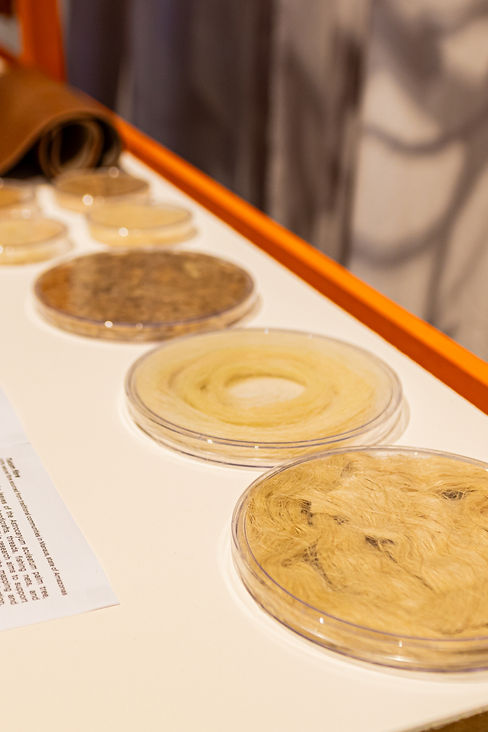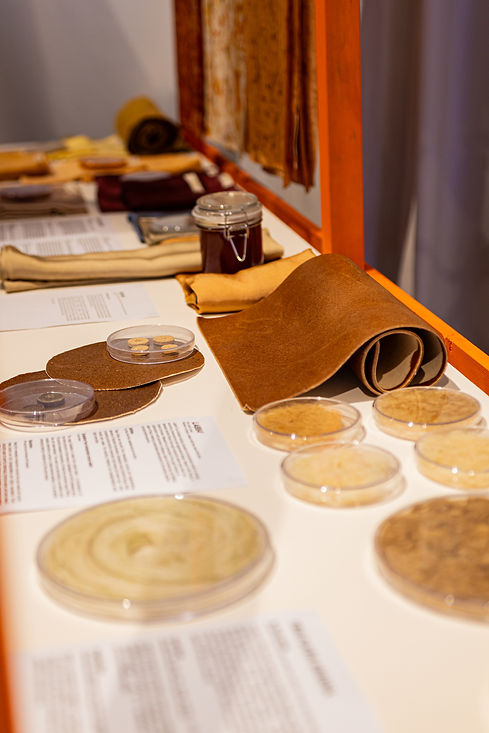Founded in 2009, Flavia Aranha is a Brazilian design and fashion brand committed to fostering sustainability across the entire production chain. Beyond her eponymous brand, Flavia created Teia – a platform that extends fashion into a wider ecosystem. Rooted in research and development of plant-based fibres and natural dyes from the Amazon and Mata Atlântica biomes, Teia offers nature-based alternatives that support the regeneration of territories and local economies. Its mission is to contribute to a new economic model grounded in ecological balance and cultural continuity.
Curauá fibres
By Teia Flavia Aranha
100% natural fibre sample from Ananas erectifolius, provided by the Amazon Biobusiness Centre (CBA) in Manaus, state of Amazonas
A resilient Amazonian bromeliad, curauá is a sustainable substitute for fibreglass and plastic. Known for its strength and lightness, it is being developed into yarns and fabrics in collaboration with cooperatives and research institutes – part of a regenerative shift away from petrochemical-based textiles.
Munguba fibre
By Teia Flavia Aranha
100% natural fibre sample from Pseudobombax munguba, provided by the Amazon Biobusiness Centre (CBA) in Manaus, state of Amazonas
Native to Amazonian floodplains, munguba tree produces soft fibres with natural thermal regulation, insect-repellent properties, cotton-like appearance and silk-like feel. Teia’s research seeks to scale its use into sustainable industrial yarns and fabrics, merging biodiversity with next-generation material science.


Tucum fibre
By Teia Flavia Aranha
100% natural fibre sourced from traditional communities in Manaus, state of Amazonas
Extracted from the leaves of the Astrocaryum aculeatum palm tree, tucum is used in fabrics, handicrafts, threads, fishing nets, and hammocks. The process is artisanal. This research aims to support traditional knowledge systems and contribute to the mapping and development of sustainable forest fibre for industrial textile production.
Malva fibre
By Teia Flavia Aranha
100% natural fibre grown in Manacapuru, state of Amazonas, supplied by the Castanhal Textile Company in Castanhal, state of Pará
Urena lobata L., or malva, stands out in the production of fibres in Brazil, constituting an important source of income for riverside families in the state of Amazonas, maintaining the process of manual extraction, taken from the stem of the plant. The purpose is to develop industrial yarns and threads working hand-in-hand with the textile industry, dedicated producers and enthusiastic co-operatives.
Courtesy of Teia Flavia Aranha
Açaí dye
By Teia Flavia Aranha
Silk, modal, cotton and linen samples dyed with 100% natural pigment extracted from açaí Pulp, sourced from cooperatives
The açaí berry (Euterpe oleracea), native to Amazonian floodplains, yields a richly pigmented pulp used in food, cosmetics, and now textiles. This natural dye is part of a broader research into developing scalable, industrial-use alternatives to synthetic dyes – transforming food byproducts into bio-based colour technology. This initiative is part of Teia, a regenerative ecosystem beyond fashion, fostering a bioregenerative economy rooted in nature, innovation, and ancestral knowledge.
Annatto dye (urucum)
By Teia Flavia Aranha Silk, modal, cotton and linen samples dyed with 100% natural pigment from annatto fruits supplied by Fazenda Bananal (Rio de Janeiro)
Derived from Bixa orellana tree, found across the Amazon, Cerrado and Mata Atlântica, annatto yields vibrant red, rose and yellow tones. Traditionally used in food and ritual body paint, the pigment is an alternative for textile applications with the aim to develop industrial dyes. This research is carried out in conjunction with national research institutes with the support of Fazenda Bananal, where the plant is grown in agroforestry in the state of Rio de Janeiro.
Jenipapo dye
By Teia Flavia Aranha
Silk, modal, cotton and linen samples dyed with 100% natural pigment from jenipapo fruits supplied by Fazenda Bananal
The Genipa americana tree is native to the Amazon and can be found in different types of forests, including floodplains. It has long been used to create intense blue-black dyes. When its pulp oxidises in air, it produces a durable, natural pigment used for textiles, leather and craft. Teia’s research aims to expand its use to industry-scale natural dyeing, contributing to forest-based economies that merge tradition with regenerative development.


Algae dye
By Teia Flavia Aranha
Silk, modal, cotton and linen samples dyed with pigment extracted from Amazonian algae. Provided by the Amazon Biobusiness Centre (CBA) in Manaus, state of Amazonas
The Amazon Biotechnology Centre (CBA) has a collection of more than 2,500 types of microorganisms. Some types of microalgae from the Amazon biodiversity are a source of proteins, pigments and fatty acids. Phycocyanin is often used as a natural pigment because it is a bright blue colour. It comes from natural sources like cyanobacteria and algae, which makes it an attractive alternative to synthetic dyes. It can be used in a variety of ways, including food and cosmetics. The goal is to develop industrial dyeing tests, measuring quality and durability.
Bacterial dye
By Teia Flavia Aranha
Silk, modal, cotton and linen samples dyed with pigment-producing bacteria from the Amazon, provided by the Amazon Biobusiness Centre (CBA) in Manaus, state of Amazonas
Most of the CBA’s collection of over 2,500 microorganisms is endophytic, isolated from Amazonian plants such as guarana, cupuaçu, oil palm, rubber tree, tucum, rosewood, copaiba and andiroba. In addition to endophytic fungi, there are also those isolated from the soil, such as filamentous fungi and the genus Streptomyces, which are of recognised industrial importance due to their broad biotechnological potential. This partnership reimagines microbial biodiversity as a key to circular, low-impact dye solutions.
Courtesy of Teia Flavia Aranha


